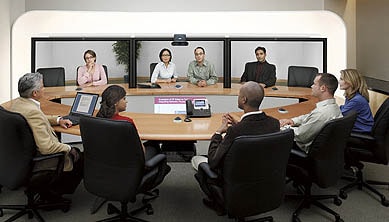Psychological Study Emphasises Importance of Visual Cues to Successful Teamwork
Bangkok, February 11, 2009 -Video communication tools can boost openness and discussions in online meetings, leading to more creativity and faster decision making. According to a new study published by Cisco today, online meetings that use video to allow participants to see each other can help build stronger relational bonds and improve rapport between people. They can also help to reduce the effects of culture and personality clashes. However, video communication can heighten anxiety and self-consciousness, and businesses need to help employees develop the right skills to make the most of these tools.

"Successful Video Communication, the study conducted by business psychologists Pearn Kandola, is the latest in a series of studies commissioned by Cisco into the psychology of business communication. How people assess another person's trustworthiness is based largely on behaviour and body language, with the spoken word contributing only 7 percent of a person's assessment, yet many businesses still rely on telephone and audio conferencing for team collaboration. This latest report explores how video communication can be used to improve business productivity in remote teams, and how psychological barriers to using these tools can be reduced.
Stuart Duff, the head of development at Pearn Kandola and leader of the research team, states: "Global and remote team communications are becoming the norm as businesses focus on cost reduction while trying to develop stronger, more productive teams. Video communication could provide a viable alternative to in-person meetings, so the significant question is how people develop the familiarity, confidence and comfort to use video communication regularly, and what factors allow those users to reap the full benefits of this leading-edge communication style."
The report highlights how video can have a positive effect on different personality types in a virtual meeting:
- The Leader/Dominator: Typically the person who leads the meeting. Not only do visual cues help to establish the leader's presence, but the participants' ability to see the whole team also means that the leader is less likely to dominate discussions.
- Energiser/Distracter: These members have sporadic bursts of engaged interaction, interspersed with long periods of distraction. Video provides a more stimulating environment for this personality type, leading to higher levels of engagement.
- Thinker/Shrinker: The quiet geniuses of the group who give deep thought to issues. With visual cues, periods of quiet thought are less likely to be misinterpreted as disengagement.
- Friendly/Talkalot: The extroverts who can talk over others or cause the agenda to drift. The ability to see colleagues gives context to natural pauses in conversation, reducing the need for these participants to fill silences.
- Creative/Impractical: Characterised by a wealth of creative and boundary-pushing ideas, these participants are kept more grounded by the richer interactions that video provides.
- Grounded/Obstructive: These 'down-to-earth' pragmatists are stubbornly rooted in what they consider reality. Video gives these persons a visual presence at the meeting, so they are more likely to have their opinions heard and to be less obstructive.
Video communication brings to the forefront the issue of culture and its effect on communication among virtual teams. For example, video can help accelerate relationship building with 'high context' cultures such as China, Japan and Middle East, where relationships are based on integrity and social interactions. Countries such as Germany, Sweden and Denmark are characterised by their 'low power distance' culture, meaning that colleagues generally relate to each as equals, regardless of formal positions. When people from low-power-distance cultures interact with people from a culture where hierarchy is much more rigid, such as the Middle East, video can provide nonverbal signs of respect to lessen the effects of these differences.
"The factors that contribute to success during video communication relate to individuals and their mindsets, how teams are managed through their leaders, and how the organisation can create a supportive culture," adds Duff. "We observed the value of visual cues in successful meetings, and video technologies that maximise this, such as telepresence, are ideal for maintaining excellent relationships. However, individuals who approach meetings with a positive attitude, leaders who understand and support the different personalities and cultures in their teams, and organisations that provide the resources and training to make video communications the norm are also essential to effective video-enabled meetings."
"Video changes everything in business communication. It adds that vital visual dimension to help us really connect with our remote colleagues and collaborate effectively across geographic and organisational boundaries," says Nick Earle, senior vice president of Cisco Services, European Markets. "This latest Pearn Kandola study shows you how to extract the maximum benefit from every type of video communication and gives fresh insights into how 'visual networking' can help businesses take productivity to a new level."
About the research
The research, conducted in October 2008, draws on a number of sources to reach its conclusions, including established research in the field of psychology and communications, live observations of video communication, one-to-one interviews with global team leaders, and questionnaires with remote team members. This is the latest in a series of joint research projects between Cisco and Pearn Kandola into the psychology of business. Cisco first began working with Pearn Kandola in 2006 with a study of virtual teamworking "The Psychology of Effective Business Communications in Geographically Dispersed Teams". The subsequent study in 2007, "Understanding and Managing the Mobile Workforce", examined the psychology of mobile working. This latest research builds on both works by examining the effects of video communications on the way remote teams work together.

